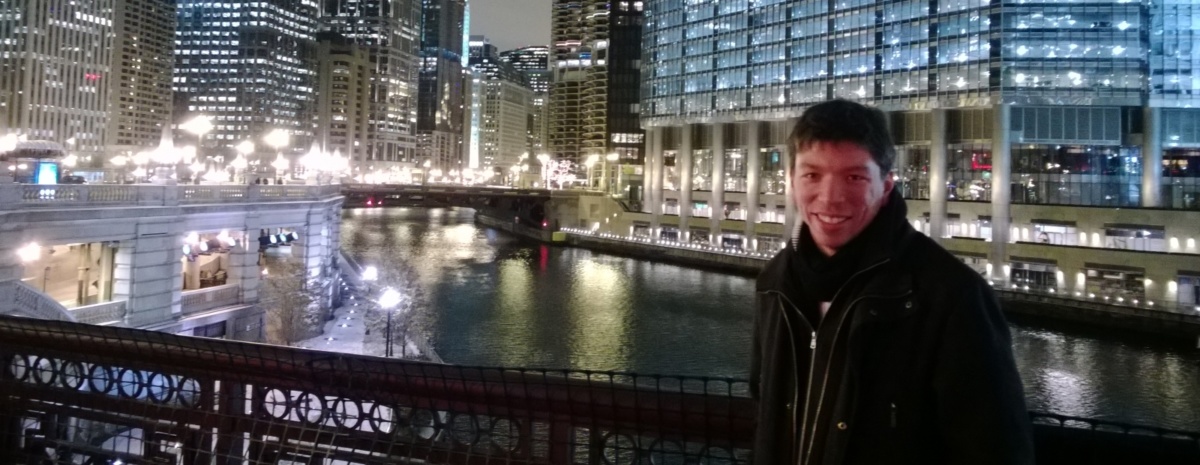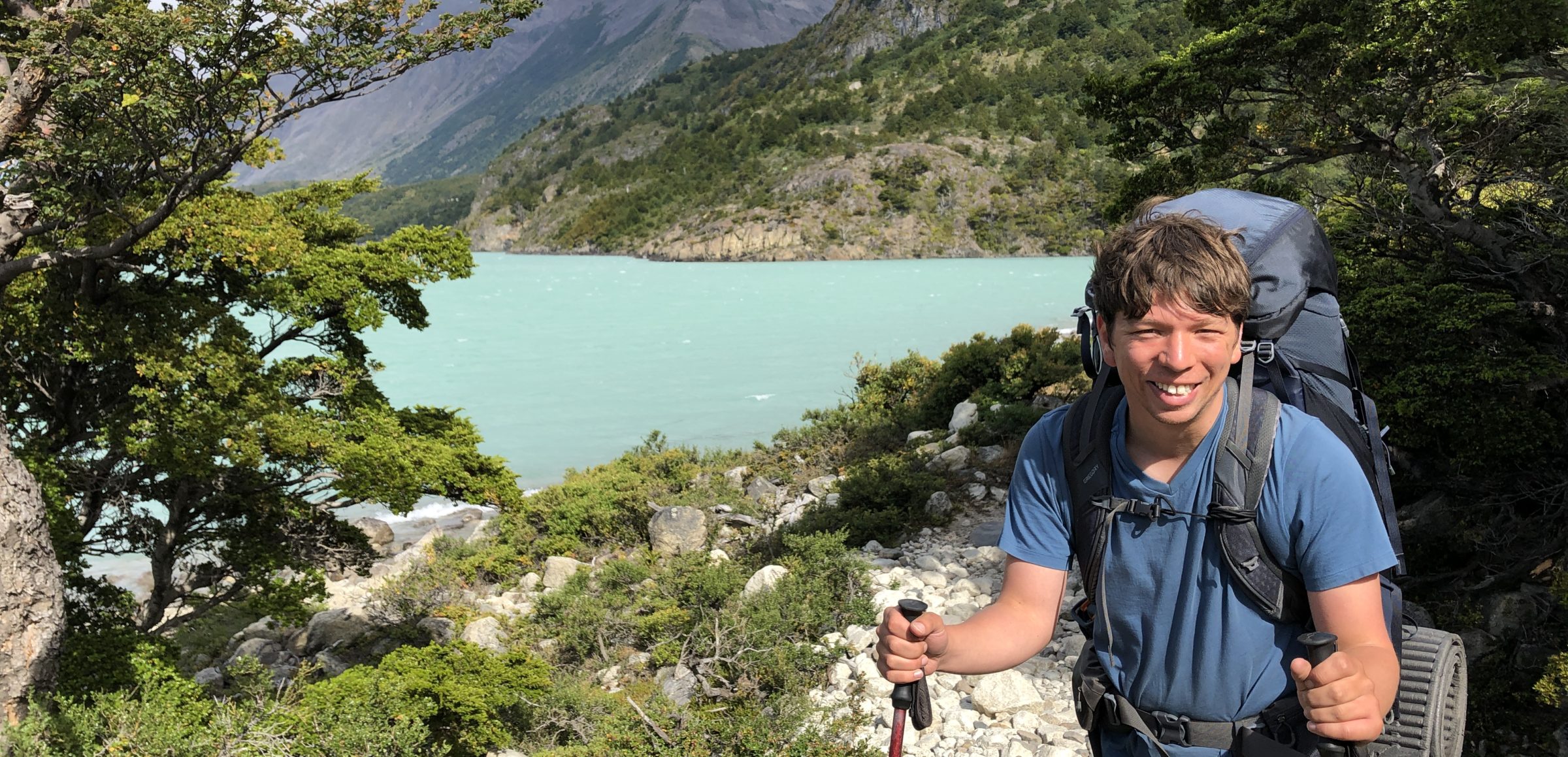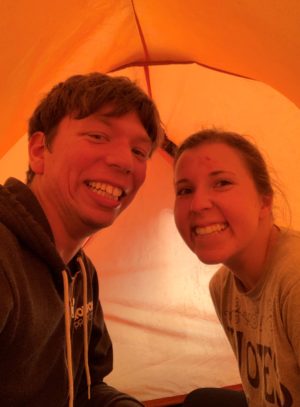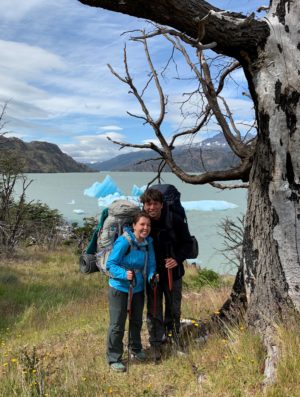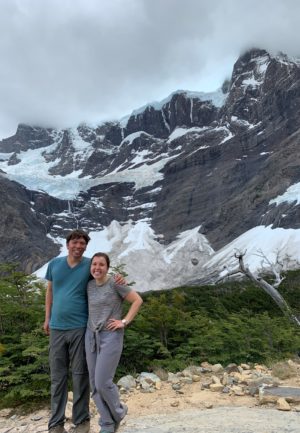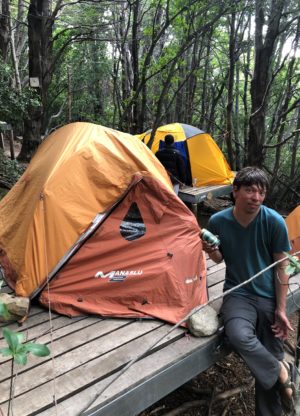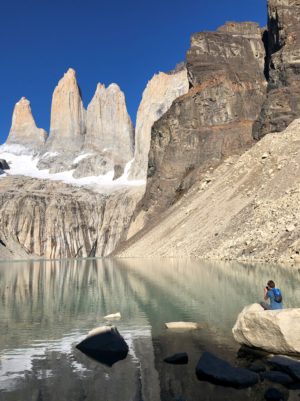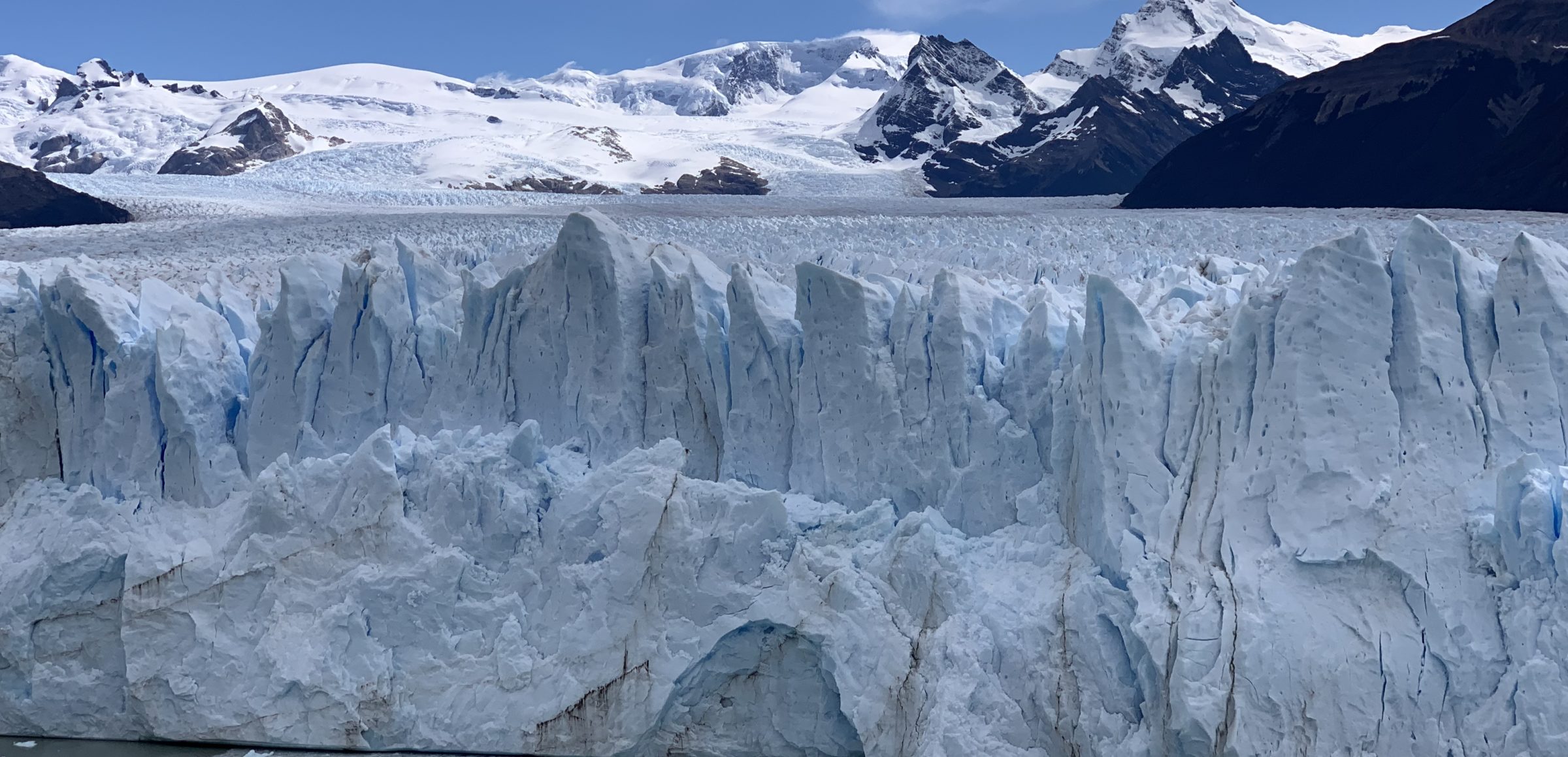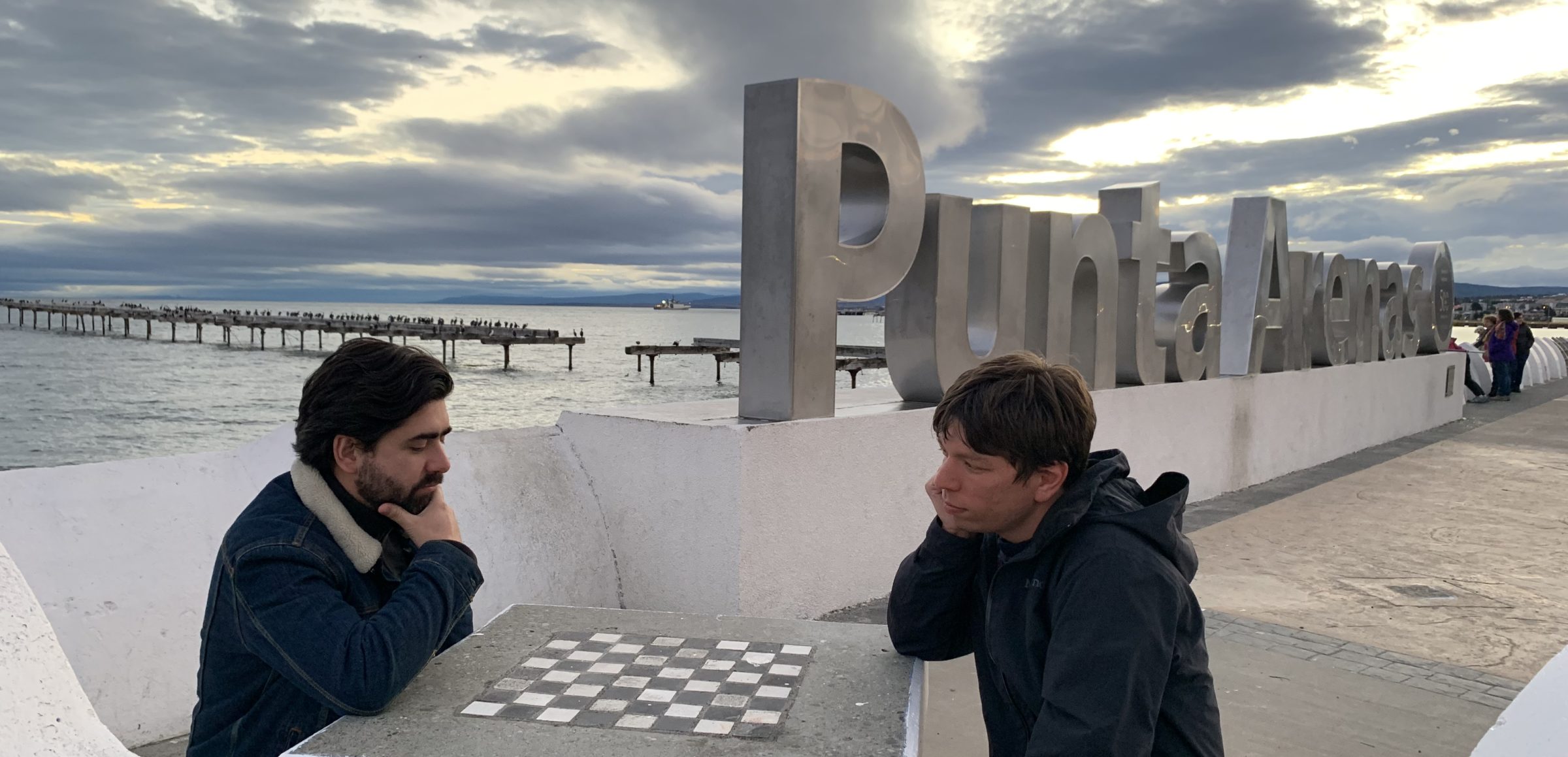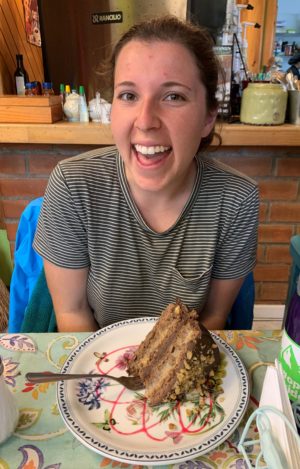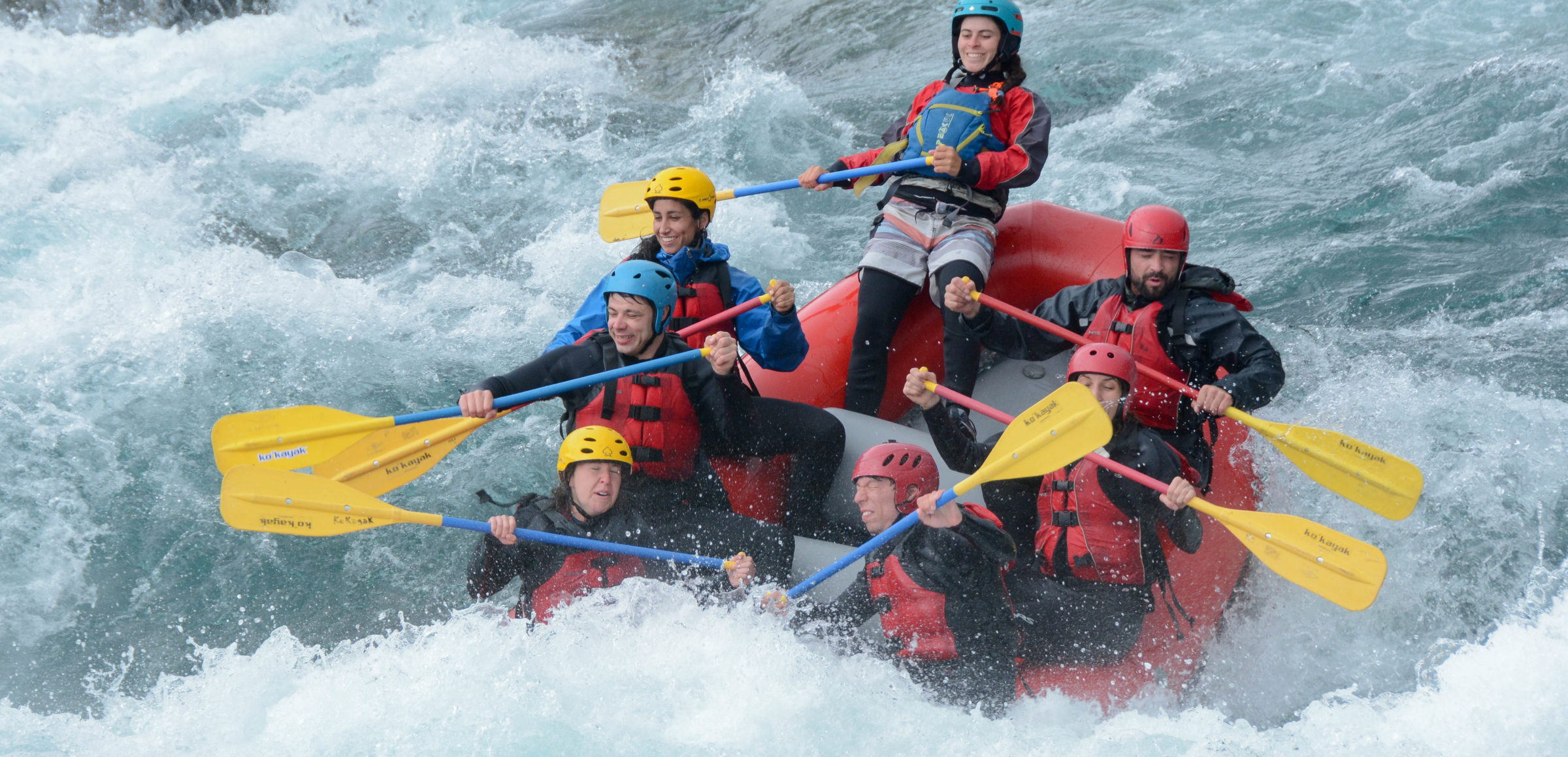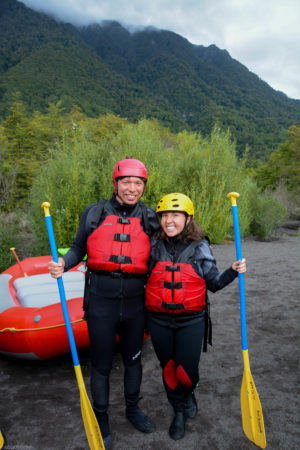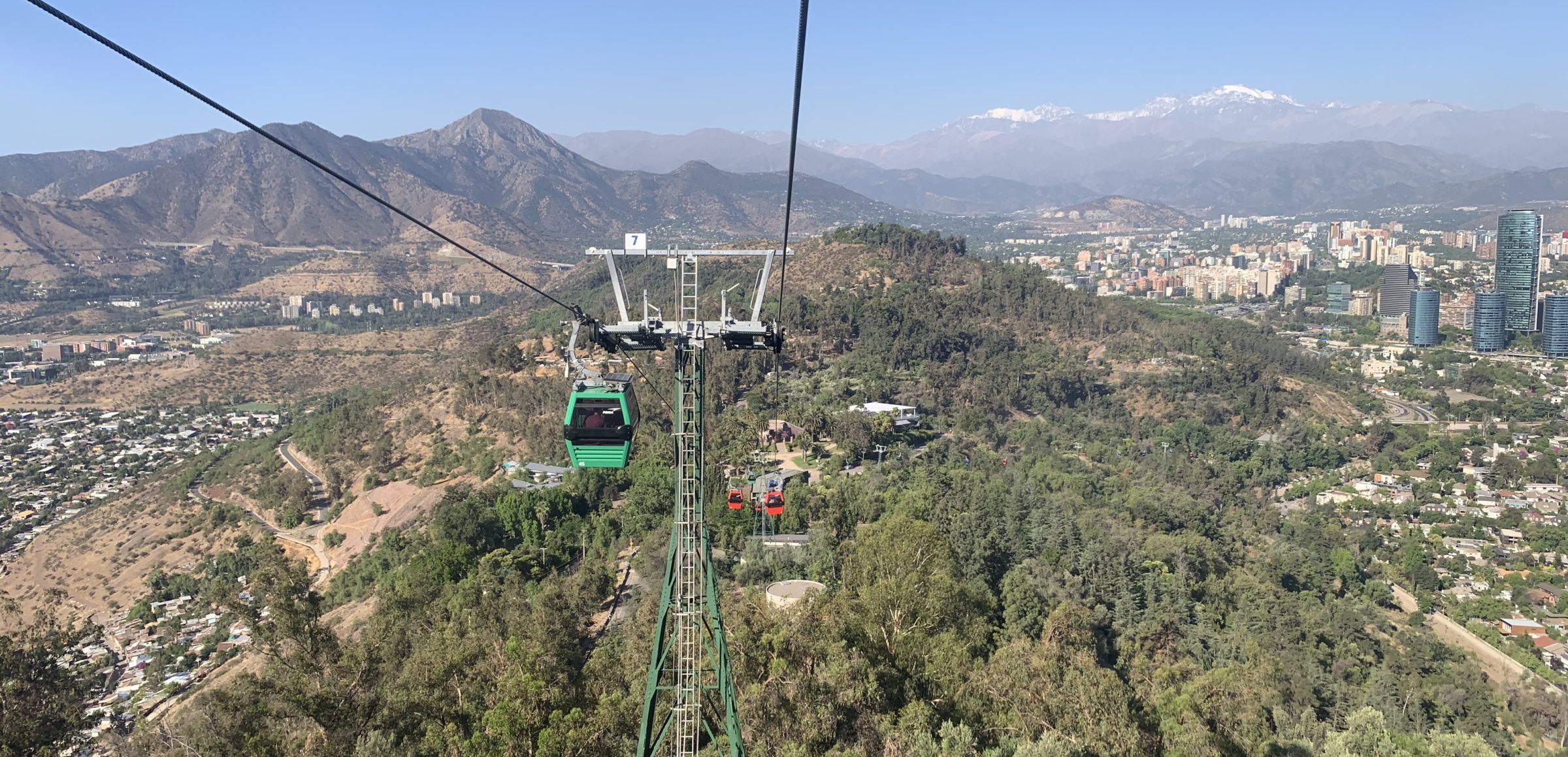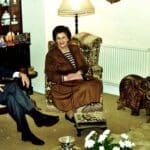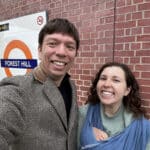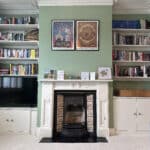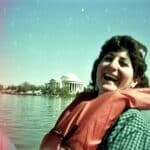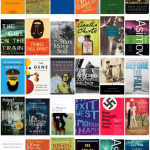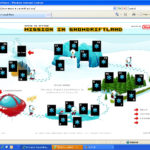We made it! Yesterday afternoon we arrived back in Puerto Natales after a successful 5 day / 4 night expedition along the famous W Trek in Torres del Paine National Park, although for us it was very much a lowercase rather than an uppercase W for reasons I will explain later. In any case there are many different ways to hike the W so, for reference, here is the version we did:
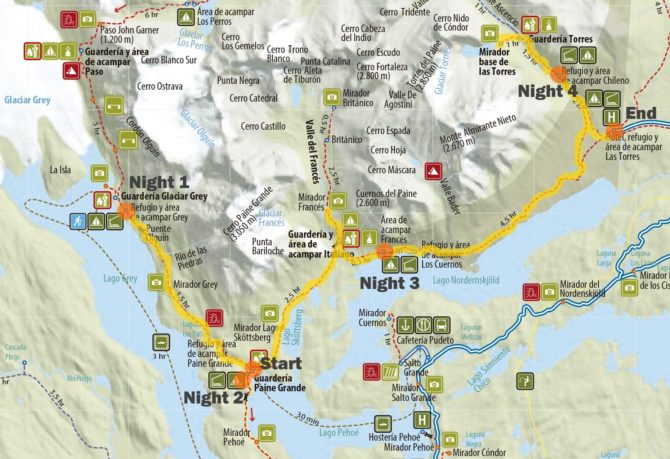
Day 1: Paine Grande – Grey (11km)
After renting our gear (tent, sleeping bags, mats, walking poles and cooking equipment) and stocking up on food in Puerto Natales the night before we got the 7am bus into the park and then waited for the catamaran to take us across Lake Pehoé to our starting point at Paine Grande. There is only one vessel and we didn’t make it onto the first ride, so after queuing for an extra hour (during which time I reached the pivotal plot twist in Donna Tartt’s The Goldfinch) it was already lunchtime before we could start our first hike.
As you can see from the map, in terms of making a nice W shape the first day’s hike is actually completely redundant since we just walked back the next day. Still, based on the distance and altitude we both expected that the first two days would be our easiest. We were totally wrong. The first day especially was the hardest. Partly this was environmental – some parts of this route are seriously windy, and there’s a fair amount of uphill and downhill sections – but mostly it was on us. Starting later in the day is definitely worse but I also wore too many layers, didn’t strap my bag up properly and had not yet settled into the walking. We were also way slower than the guide time of three and a half hours, which wasn’t a problem in itself but was worrying given the subsequent trips we had to make.
The worst part was when Randi tripped and fell forwards onto a rocky downhill path, which left a cut on her forehead but thankfully no serious damage. We’re grateful to the helpful group of French hikers behind us who stopped to offer aid and checked for concussion before moving on! Serious public service announcement though: when we rented the walking poles, the woman at Erratic Rock warned us not to use the wrist straps. We followed her advice, and Randi was able to throw off the poles when falling. If she hadn’t been able to she could easily have broken her wrist and wouldn’t have been able to shield her head. So please follow the advice and ignore the wrist straps on walking poles!
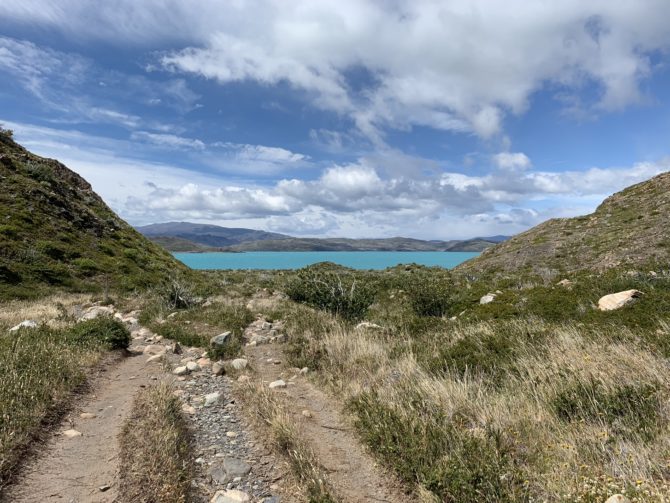

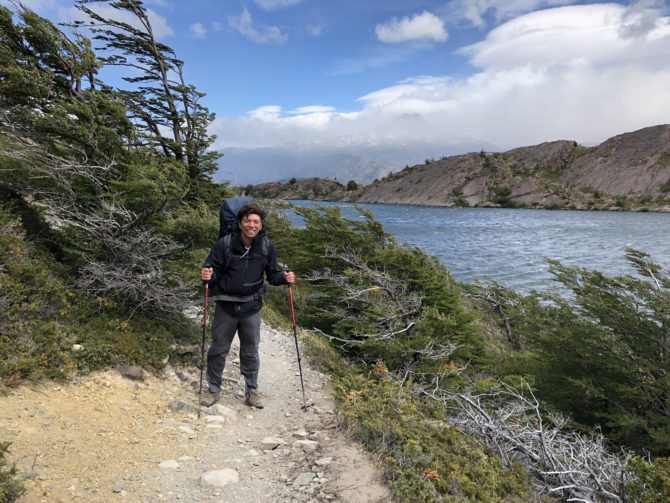
Suffice to say, we were both extremely glad to reach Refugio Grey, put up our tent, take a hot shower and cook our first dinner using the little foldout burner which looked eerily like a robotic spider from a Doctor Who episode.
We also dutifully followed the camp’s rules and left all our food tied up in a bag and dangling from a tree overnight, even though I was pretty convinced that we would wake up the next morning to find five days worth of food spread all over the campsite. Spoiler alert: we didn’t! And so after a long day we had a recuperating and relatively comfortable night’s sleep in our tent, which joyfully didn’t blow away either.
Day 2: Grey – Paine Grande (11km)
I’ve deliberately focused on the worst parts about the first day’s hike so I would have something to write about here 😉 and I do, because the journey between Grey and Paine Grande offers amazing views of Glacier Grey! As we set out in the morning I wasn’t sure if knowing the route in advance would make things easier or harder but we did much better the second time around (only half an hour slower than the guide time) with no falling over and happier spirits overall.
Some of this might have to do with the delicious breakfast of porridge and calafate jam, topped off by tea and even some milk which was donated to us by a kind (but very unhappy) Australian woman. “The Australian woman” became a bit of a talisman for us, actually, as she kept popping up at various points along the route and complaining bitterly to Randi about what a miserable time she was having. Any of our problems seemed very mild in comparison.
We arrived at Paine Grande, struggled to put up our tent (not because it was hard but because it looked wrong, which we eventually decided was the wind’s fault) and then copied everyone else by placing large rocks over the stakes just in case. After dinner we also bought more eggs to hard boil, having very much appreciated this snacking suggestion from a Canadian back in our hostel in El Calafate. Thanks for the great idea!
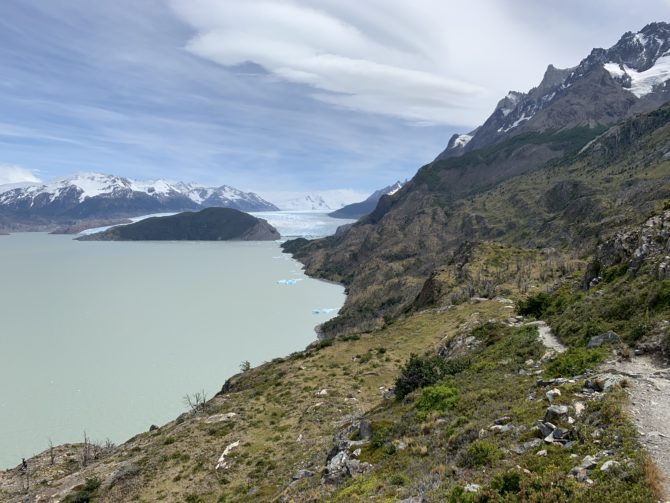
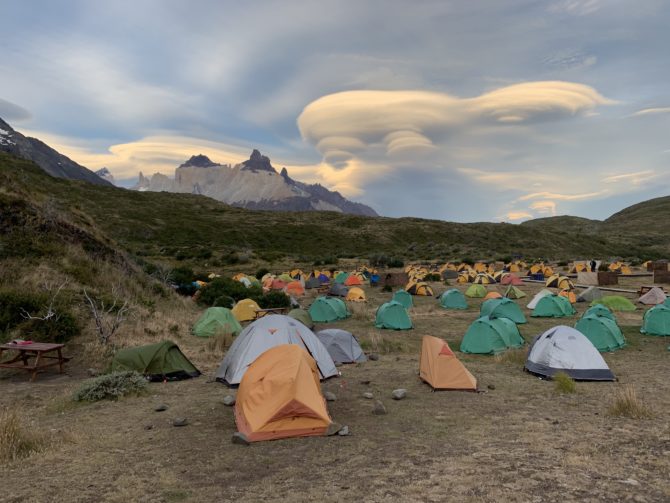
Day 3: Paine Grande – Mirador Francés – Francés (13.5km)
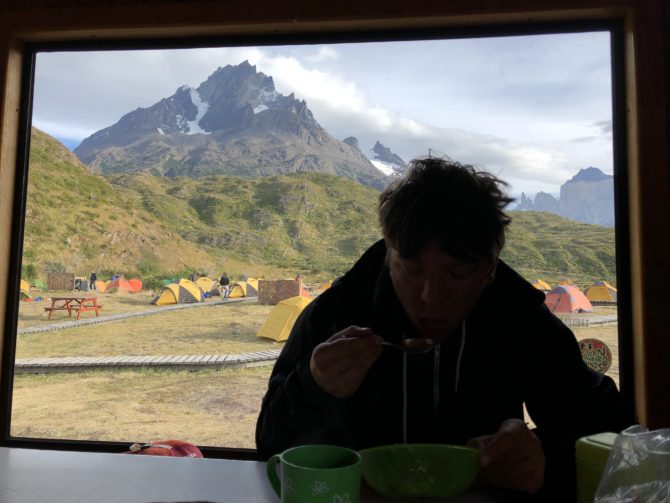
By the third day we were really hitting our stride and by this point onwards we either met or exceeded the guide times for the routes. After walking to Campamento Italiano (this is the basic campsite run by the park itself, which is free but does not come with any fancy frivolities like flushing toilets or showers) we left our bags and walking poles and headed uphill on the way to the Británico lookout.
This is where the ‘lowercase W’ comes in, because we didn’t get anywhere close to Británico… in fact, we almost turned back before reaching any great sights at all – which would have been a real shame – but luckily someone who was coming back down saw our tired faces and volunteered the information that Mirador Francés was only five minutes away. (In fact, he even called it ‘the main viewpoint’ which makes me feel a lot better.) And so we reached this checkpoint and declared victory, leaving Británico as a reason to come back to Torres del Paine at some point in the future.
As well as feeling that we had rescued success from the jaws of failure I also enjoyed Mirador Francés because it turned out that the couple we stopped and asked to take our photo were from Nottingham but the woman was originally from Willesden! Normally this would be the very lowest rung on this type of conversion (“Where are you from?” “London” “Where in London?” “North West London” “Where in North West London?” “Willesden”) but I was delighted to be able to go one deeper with the never-before-uttered “Where in Willesden?!”, although then she responded with “not the Green!” so we didn’t quite get to street level. Even so – standing at the top (OK, the middle) of a mountain in Chile – I felt an instant bond with this woman from Willesden and hope very much that she and her partner made it down in time for their boat.
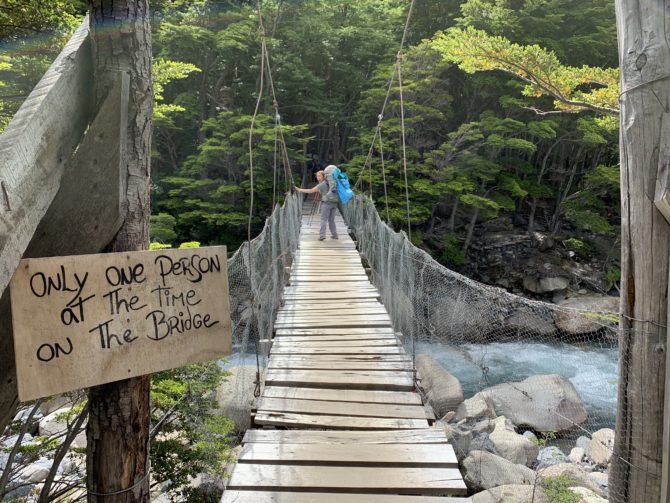
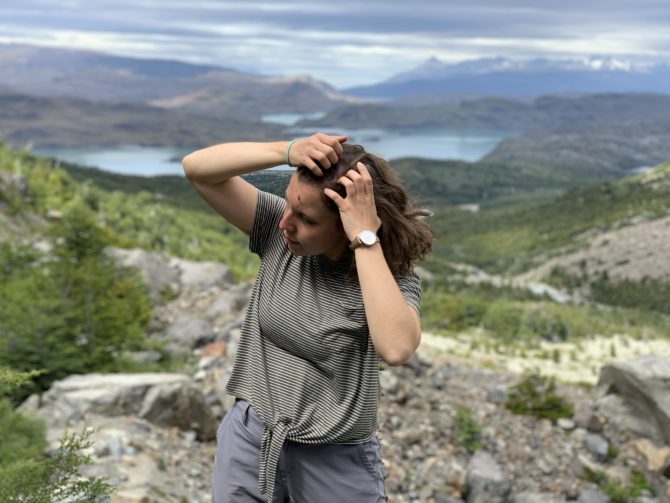
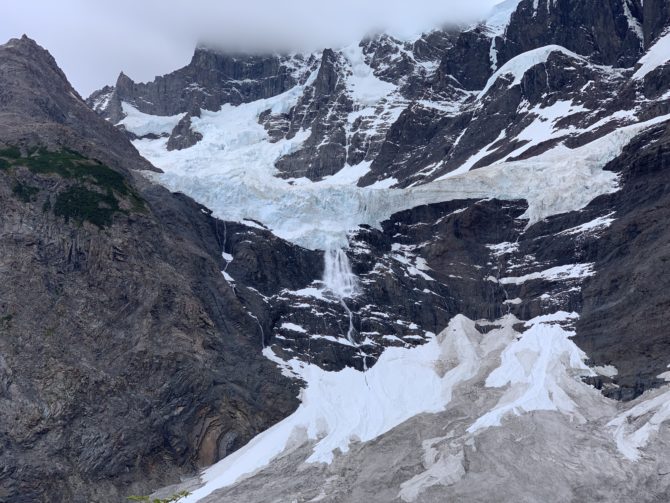
After making it down again we only had a short 2km walk on to the Francés campsite (yes, this one does have showers – rather nice ones) and set up our tent on a wooden platform. I acknowledge that the hills might make platforms necessary in this area but our tent didn’t really have enough ropes to tie down so we ended up with a rather sad-looking tent. We shrugged this off by purchasing two cans of Austral lager (it’s really good) and then cooking our pasta on the edge of the platform. This was the only place where we were allowed to actually cook outside (which was nice) although it was also the only place where we accidentally dumped our entire dinner onto the ground while trying to strain the water. Wah-wah. The very good news was that we had a backup rice packet ready to go which ended up tasting even better with our sauce and tuna. It was still a true moment of failure but I was just glad we hadn’t burnt the tent down.
At Francés we were sheltered from the wind, and the thunder-like noises which rumbled on intermittently in the background were actually just the avalanches which go on all the time. But that night, as I was lying in my sleeping bag reading the very last chapter of The Goldfinch, I heard the pitter-patter sound against fabric of our first rainfall.
Day 4: Francés – Chileno (18km)
Happily, we awoke in the morning to find that although it was still raining our tent had kept everything relatively dry and after breakfast we set off early for our longest walk of the trip. Back at our prep talk at Erratic Rock we had been advised not to faff around too much with coats and waterproof trousers and bag covers and the like and just embrace getting wet, so in this spirit I decided (for the first time) to start hiking in only my t-shirt and kept it that way despite the rain. I can’t be sure whether this would have been a good decision if we had been seriously drenched but as it happened the rain stayed relatively light before disappearing completely by the afternoon, never to be seen again. And wearing only one layer definitely felt better and added a good psychological incentive not to stop too much in case I felt cold.
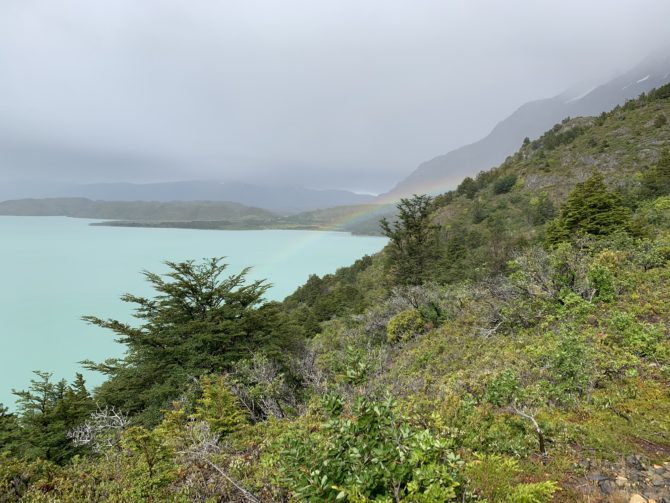
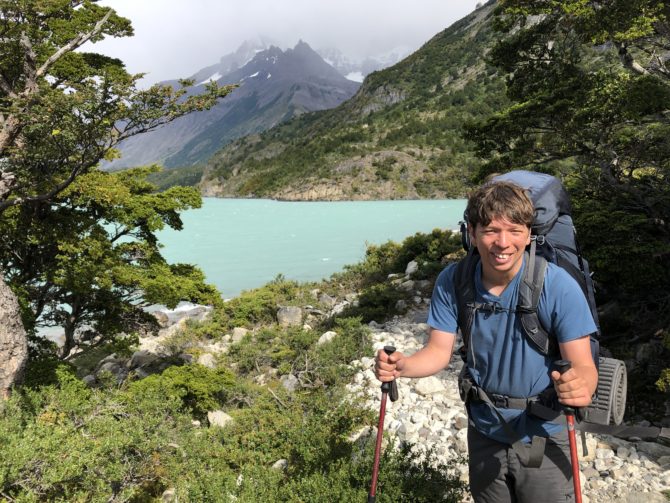
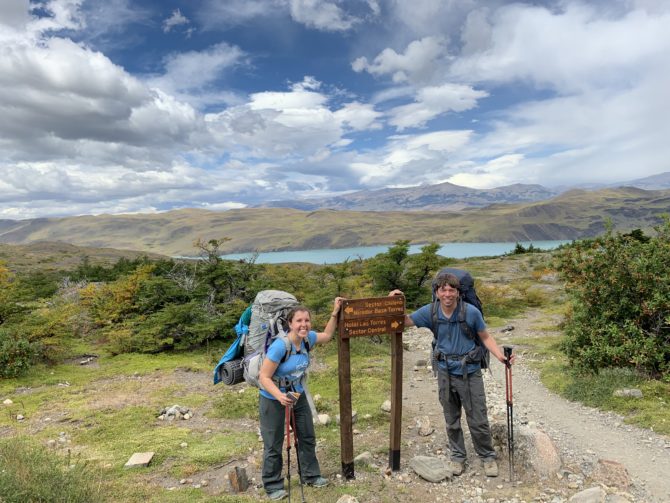
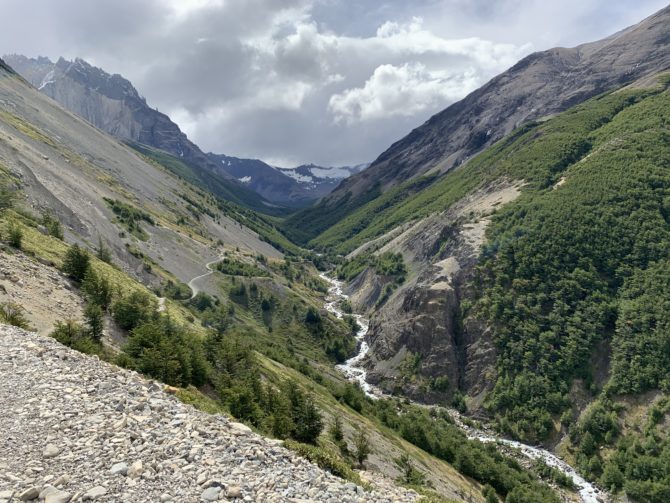
For whatever reason we completed this journey faster than expected and what was supposed to be the hardest day ended up feeling the easiest. The terrain was also flatter, the path more secluded and with less wind we could hear each other well enough to start playing word games to pass the time. We reached Chileno, checked-in to our dormitory – despite booking well in advance, this refugio had already run out of camping spaces by the time we planned the trip – and I celebrated with the priciest but nicest Fanta I’ve ever had. I don’t care if that sounds anti-climactic: you weren’t there, you didn’t drink this Fanta. It was amazing. Things got even more luxurious at dinner as you’re not allowed fire at Chileno, so instead of eating sad and cold food we paid for a hot dinner and I had a very tasty beef sandwich/burger thing. I’m not completely sure if the reason it tasted so good was because we didn’t have to cook it ourselves but I don’t think that’s (completely) true.
Day 5: Chileno – Mirador base de las Torres – Hotel las Torres (13.8km)
Apart from not reaching the Británico viewpoint the only other canonical part of the W trek which “you have to do” (but we absolutely did not do) was wake up at some ungodly hour and scramble up a rocky cliff edge for several hours in pitch black in order to see las Torres at sunrise.
Instead we left at 7am and saw the park’s eponymous towers by daylight and they were quite beautiful enough, thank you very much. Don’t believe everything you read on travel blogs, kids.
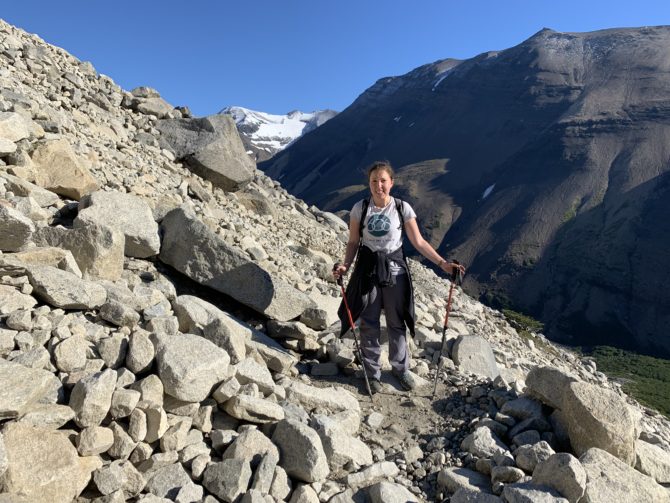

We did feel a bit pushed for time on the last day because we wanted to catch the 2pm shuttle bus out of the park rather than waiting for the later one at 7pm. So we set off back down from las Torres at a determined pace, stopping quickly for lunch and final repacking at Chileno before continuing all the way down to the hotel and welcome centre at the eastern entrance to the park. Thankfully it became clear that we were decently ahead of schedule and although my knee was hurting from the steep descent I was mostly just feeling very, very glad that we had never had to walk this path in the other direction. Sure, we must have covered the same altitude on the previous day, but our route had never felt like a nasty uphill slog.
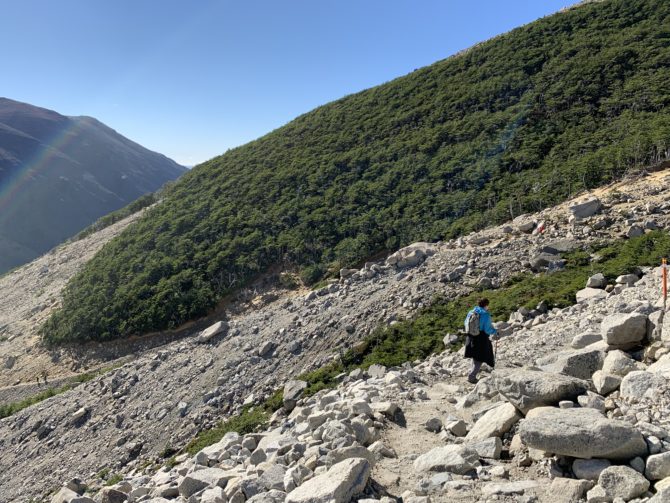
Since we had been going downhill we weren’t even particularly wiped out by the time we reached the welcome centre, paid for the shuttle bus and rode back into Puerto Natales. But we did feel a sense of accomplishment – we’d completed the W trek, and enjoyed it! We got back into town with enough time to return all of our rented equipment, check back into the Airbnb where we had left the rest of our stuff and then celebrate with drinks, pizza and dessert pizza. Also, we could throw out stuff into bins again! When you have to carry everything on your back it is really annoying not to be able to throw away rubbish. Yes yes, I understand why. I’m just saying that bins are an under-appreciated part of civilisation.
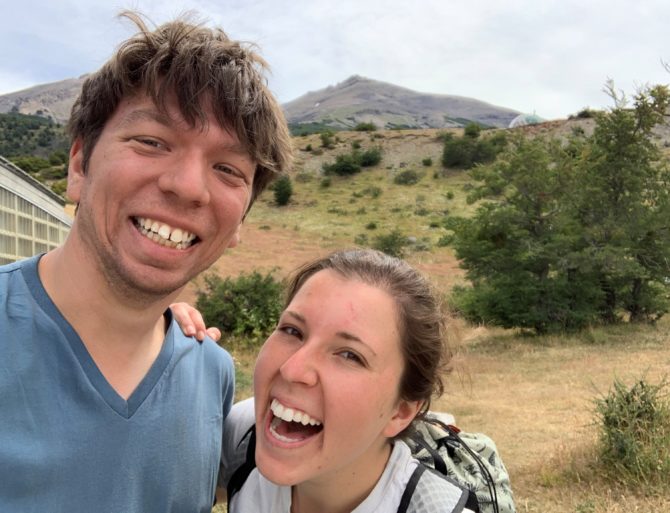
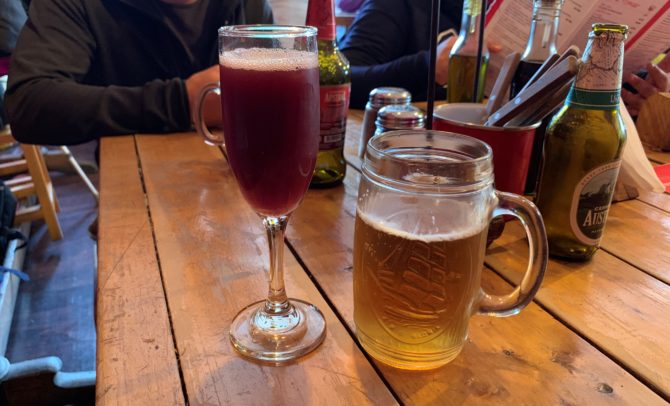
Final Thoughts
Although the W Trek was my first multi-day unguided trek I had felt pretty ready for it given that I’d already done most of the constituent parts over the years (hiking, camping, getting used to sleeping bags) and had even accumulated most of the equipment to do it comfortably. In fact, special shout-outs are due to Tash for a microfibre towel, Jesús for the waterproof bag and Randi’s mum Beth for my hiking shoes – all of these gifts over the years really came together on this trek!
There’s very little that I would change if I were doing it again. The biggest thing I’ve learnt is probably to buckle and tighten all of the straps on my backpack, even the fiddly little side ones which seem superfluous. And also that earlier start times really do make a big difference. I was a little bit worried about my back because it had started hurting in the week leading up to the trek, but was pleasantly surprised to discover that so many different body parts started to hurt over the course of the W – one day my shoulders, the next an ankle – that by the end I had completely forgotten about my back and could enjoy a real anthology collection of aches.

For anyone still reading (and I expect even Randi’s parents – who apparently take turns reading our blogs out loud – have given up by now) I have two more important notes about the W. The first is that some of the signage is just flat-out wrong. It’s really odd, because the whole thing is generally very well-organised, the trails are very popular and busy and you’re given a decent map to use on the way in. But then some of the engraved wooden signs state utterly wrong distances or have landmarks in the wrong place, to the extent that someone has made corrections with a ballpoint pen. Dear CONAF: maybe you should fix this?
The second thing is that when walking for this many hours you are bound to get a jingle stuck in your head, so choose wisely. Mine was la vida es más fácil from Chile’s Unimarc supermarket, which can be heard here in a cheesy 80s ad but is still played at regular intervals in-store and is really quite delightful. If Jewel in Chicago played a theme tune which was even half as good as this I would never have complained about them.

Tomorrow we get back on a bus to Argentina and thinking about this made me realise that Chile – even accounting for the interruption to visit El Calafate in Argentina last week – is probably now third after the UK and the US in my list of countries by longest consecutive stay. (Non-consecutively I think France is probably third, but I’d have to check some things with my mum on that one.) So farewell, Chile! It’s been a lot of fun.
This is my first post from Argentina! We’ve hopped over the border from Chile and are in El Calafate, which I think people only visit if they plan to see the Perito Moreno Glacier. Oh, sure, there are options for seeing the glacier. You can go with a guide, see it up close from a boat or pay a lot more and hike on top of the glacier itself. We are counting our pesos and so did none of these things, but the simple bus and walking trip alone was well worth it, and so – fair warning – there are an awful lot of glacier photos in this post.
But first we have to start with our bus from Punta Arenas to Puerto Natales, where we stayed for one night and attended the ‘3 o’clock talk’ at Erratic Rock to prepare for our upcoming Torres del Paine trek. Ezra (from Chicago) was incredibly helpful and, I thought, very patient with some of the questions at the end, including “so, do I need to book the campsites in advance?”. Yes, yes you do. Months in advance. We had also reached a remote enough part of the country where prices become truly ridiculous (10,000 CLP for a small calzone in a bakery, which is currently $14.75 or £11.57) but thankfully Erratic Rock was adjacent to a pub with cheap and tasty pizza.
The next day we boarded another bus and crossed into Argentina. Naturally, this involved filing out of the bus and queuing up for our Chilean exit stamp in one building before driving down the road and doing the exact same thing to get new entry stamps. Eventually we arrived at our hostel in El Calafate. You can tell I’m not a real traveller because this is actually the first time I’ve ever stayed in a shared dormitory, but everything was pretty uneventful on that front (no murder, no theft, and best of all no waking up at 3am) and in fact it was us who ended up being the most antisocial idiots, locking my keys in my locker and requiring the lock to be cut through with a saw.
Anyway, the glacier!
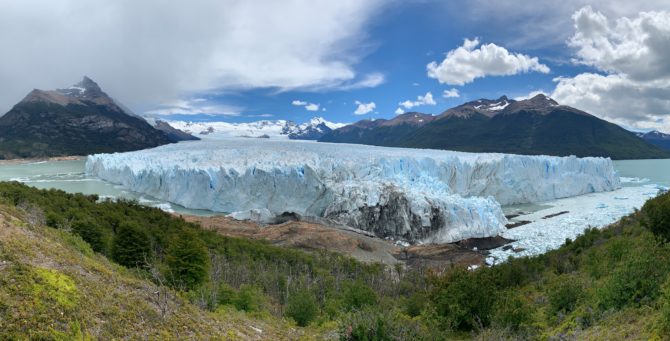
It really was beautiful and photos are not going to do it justice. First of all, it’s huge, so it’s very calming to just stare at it from across the water. The cracks in the ice glow with a pale blue light and the air is frequently punctuated by loud thunderclap sounds as chunks of the glacier break off and fall away. Each time this happened we whipped our heads around to try and see it, normally failing but occasionally spotting the ice and snow tumbling down. Never fear, though, because the best thing about this glacier is that – for once – it’s actually not melting at a frightening, climate-change induced rate. Everything has been in “a quasi steady state with no major changes in its size during the last and present centuries”, at least according to the reassuring sign on the path. Though emphasis on quasi steady – don’t get too close or you might be sliced open by debris.
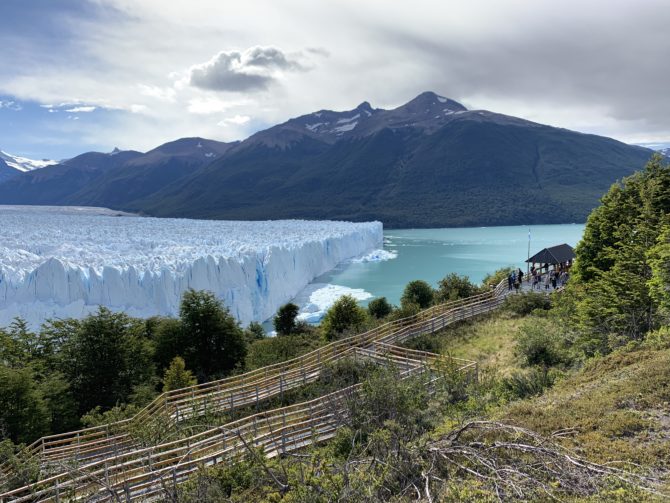
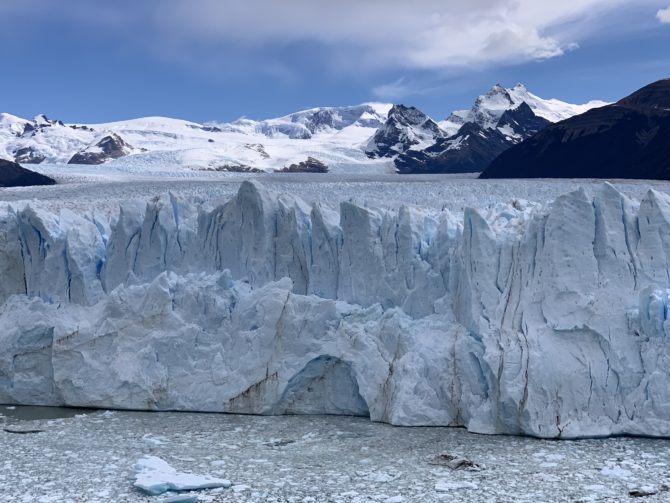
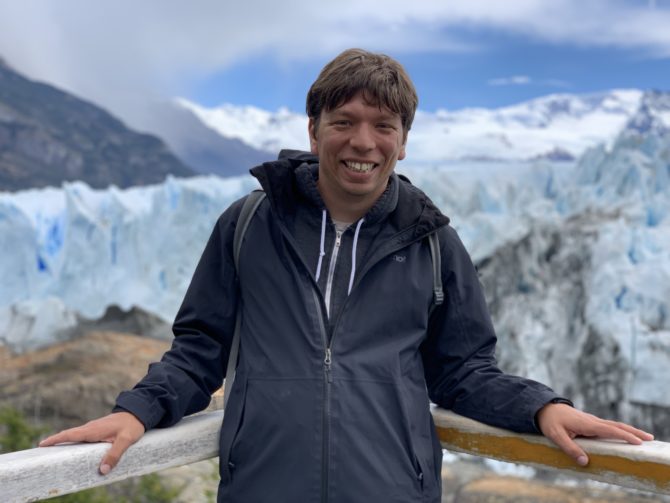
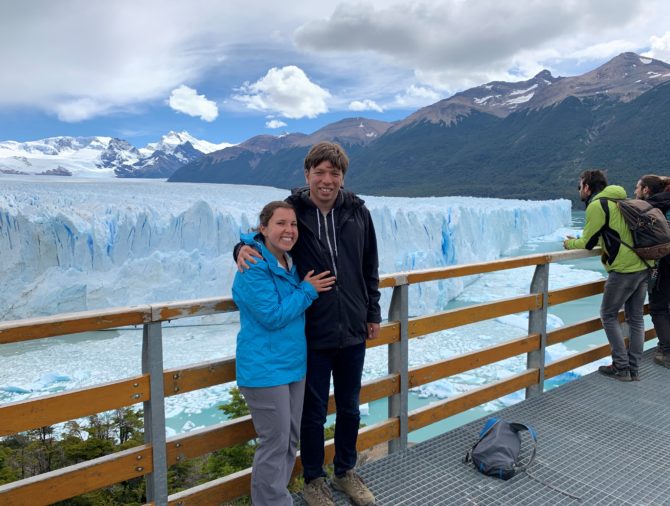
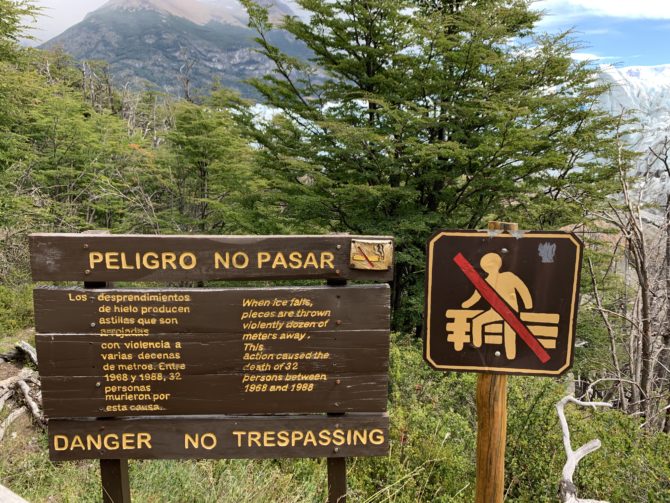
We haven’t really done much else in El Calafate and are riding the bus back to Puerto Natales tonight to rent all of our hiking equipment and stock up on supplies. As you can see below, El Calafate does have some nice marshland by the lake where you can see flamingos and other birds, and the main street has a bunch of shops and restaurants to justify a couple of days’ stay. It’s really all about the glacier, though.
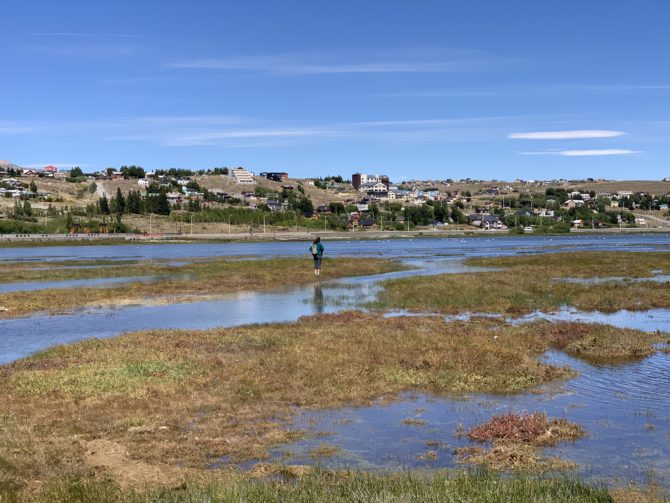
For the last couple of days we’ve been pretty quiet and chilled in the city of Punta Arenas, which is on the Strait of Magellan and is a frequent jumping-off point for other far-flung destinations – including Antarctica. “We’re at the end of the world!” cried the owner of a lovely little café here where I had my first pastel de choclo*, and I’ve certainly started to make use of the jumpers which have otherwise just been taking up space in my backpack. It was also very strange when we walked home after midnight one night with light still visible at the edge of the sky.
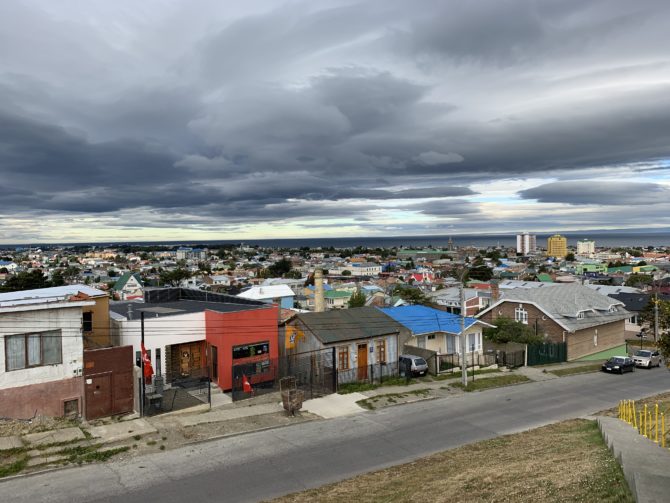
This is the city where Carolina grew up, and the most important thing I did here was reunite with her and Francisco to share some truly excellent pizza, drink a rhubarb-flavoured Pisco at their friend’s bar and argue with Francisco about the logic of ice-cream cones. (In Chile, it is common to serve ice-cream in a cup with an upside-down cone on top. This is manifestly ridiculous, like putting an egg-cup on a plate of scrambled eggs.)

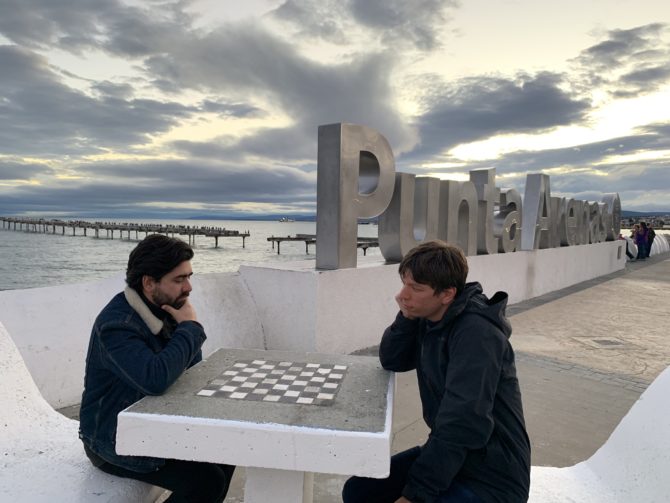
We also checked out the city’s cemetery, which (Wikipedia informs me) made it into CNN’s list of the top 10 most beautiful cemeteries in the world. It is very nice. It’s also filled with the most phallic trees you can imagine. I’m not offering that as a pro or con, just stating it for the record so you can make an informed decision about your cemetery visits.
Other than this, we didn’t do an awful lot of touristy stuff as we are saving our energy and money for the Torres del Paine trek which we start in a week’s time. Our economising last night with a stay-at-home dinner was almost ruined when we were unable to work the AGA-style cooker, but luckily one of the AirBnb owners turned up before we had burnt off our eyebrows. (Apparently this is exactly what happened to their very first AirBnb guest.) Tonight, however, we ate out and shared this rather incredible cake.
*The owner of the café later asked to take a photo of us so she could share that she had foreign diners on her Facebook page. “Suddenly your Russian relatives will arrive!” commented one person.
We’ve spent the last week in Chile’s Región de Los Lagos. The area gets marketed as the ‘Lake District’ which causes me a little cognitive dissonance (what do you mean another country has a district with lakes?) but the connection is actually fairly appropriate given the weather. Whereas Santiago reminded us both of California this region is much more similar to the UK, with cooler (but not cold) temperatures and short, unpredictable rain showers which confuse Randi.
For the first (and almost certainly only) time on our travels we rented a car from Puerto Montt and drove – via a car ferry – to the island of Chiloé where we spent our first three nights in a town called Dalcahue. While in Chiloé we had intended to visit Chiloé National Park but after missing the entrance and instead following Google Maps for far too long up a tsunami evacuation route which reminded me of Hugo III, Jungle of Doom we turned around and ate our sandwiches and beloved Cheezels on the beach instead, happy to have made it out alive.


Shortly afterwards we picked up three hitchhikers (a Chilean, a Colombian and an Italian – I have no idea what happens if they walk into a bar) who wanted to go to the Muelle de las Almas which seemed like as good a plan as any. Ultimately the hitchhikers abandoned this idea when they discovered the entrance fee, but Randi and I persevered and had a good walk culminating in an awesome view.
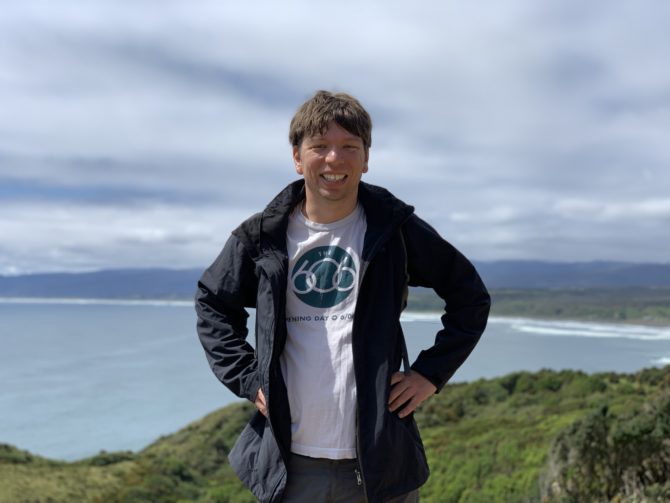
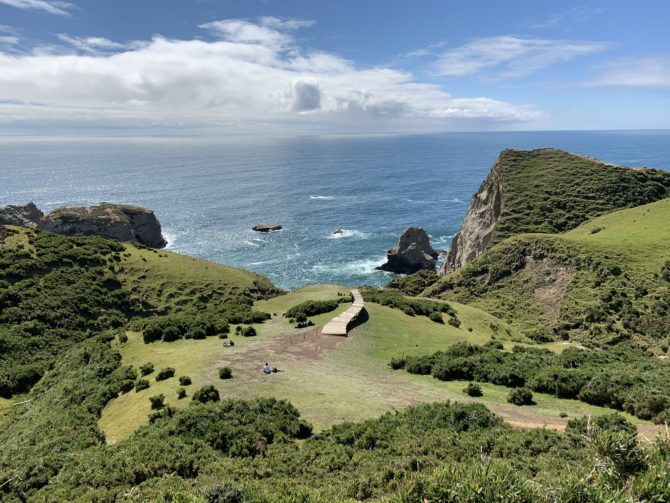
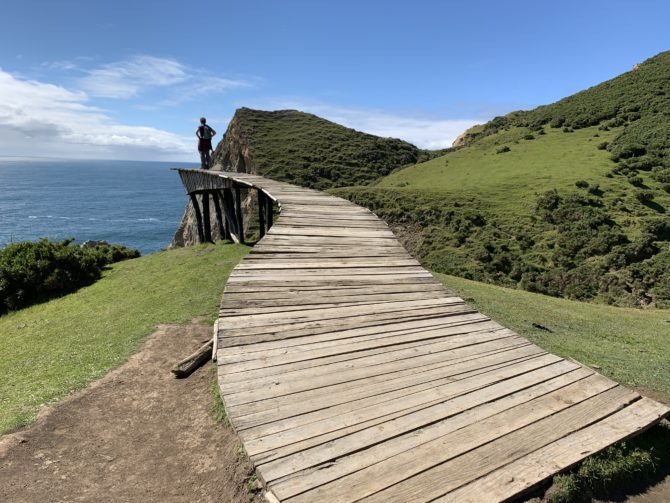
The next day we eschewed driving and caught a local ferry to a neighbouring island, ending up in the seaside town of Achao. (I’m pretty sure you don’t pronounce this as a sneeze but it’s too good to pass up.) This is going to sound unflattering, but with its grey skies and rain Achao had that faintly miserable air of the seaside which is very enjoyable and rather invigorating, especially after a hearty local lunch. (You can tell it’s a local lunch place because there are no menus.) I can also confirm that the local bus service is much better than in the UK’s Lake District.
Side-note: Chilean breakfast television is terrible. I know this doesn’t sound like big news, but we watched the teenage son of a murder victim stood in the street for a full 45 minutes so that an in-studio panel could ask him questions and then debate the issue amongst themselves. 45 minutes! It was mesmerising.
Anyway, we left Chiloé and returned to the mainland for a further five nights in Puerto Varas. We’re staying in a nice hostel and I particularly appreciate the morning tea, although (and I can’t believe I haven’t mentioned this yet) it is slowly dawning on me that all of the milk on our travels will be UHT, and it may be many months before I lay my hands on fresh milk again. I have new gratitude for growing up in a country with dairy farms.
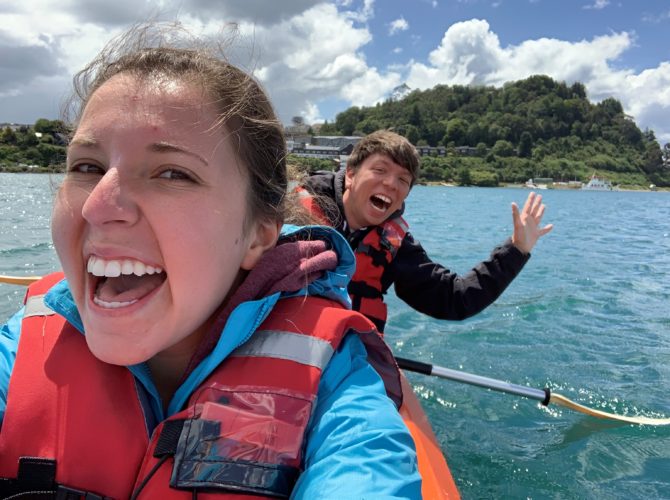
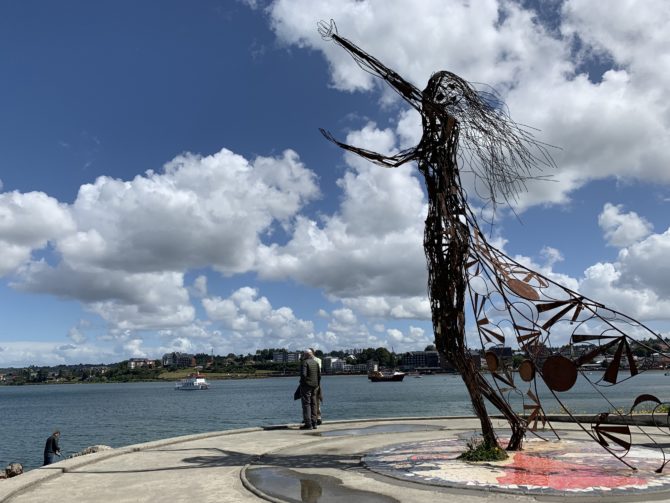
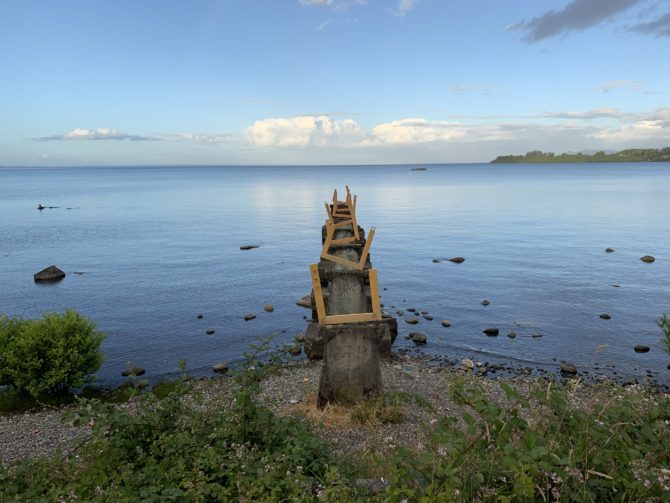
After some light kayaking on the lake (until we needed to go against the wind, at which point the paddling became a little less light) our first full adventure here was hiking the Desolation Trail. This name makes it sound a lot worse than it is as the hike is relatively flat – though at times frustratingly sandy – unless you choose to do the 4km tangent up the mountain to the viewing point. Naturally we got to this just as it started to rain, which made us feel smart for carrying raincoats and very accomplished for making it to the top but did rather mist up the view.
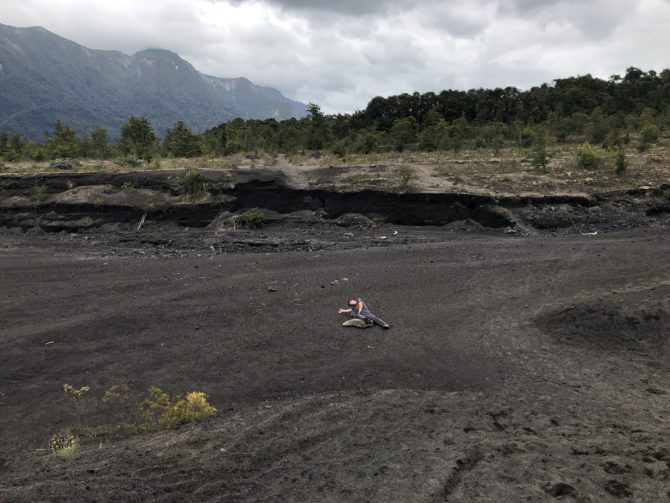
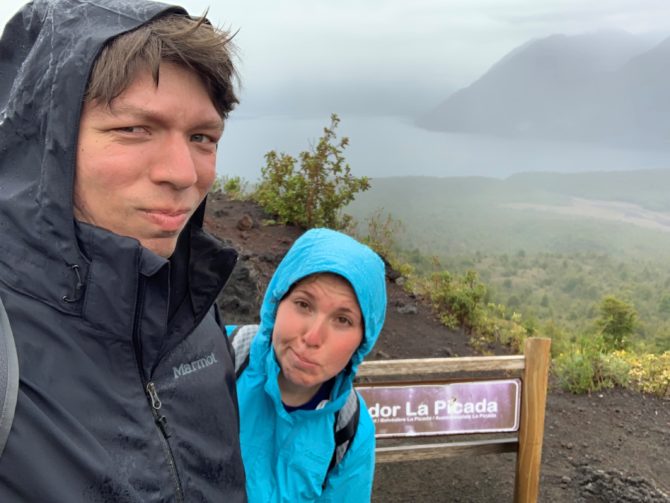
The next day we went whitewater rafting on the Petrohué River, which was insanely fun. I have to say that it made our rafting in Yellowstone feel rather tame, as the rapids here were much bigger and almost enveloped the whole raft. Highly recommended if you are in the area, and for a small additional fee we also got the best set of photos I have yet seen on this kind of tourist activity.
We got back in time to join our hostel’s New Year’s Eve barbecue, and while we did technically stay up until midnight this year (not always a given, especially when travelling) we were already in bed by this time and only heard, rather than saw, the town’s fireworks over the lake. I’m sure they were lovely.
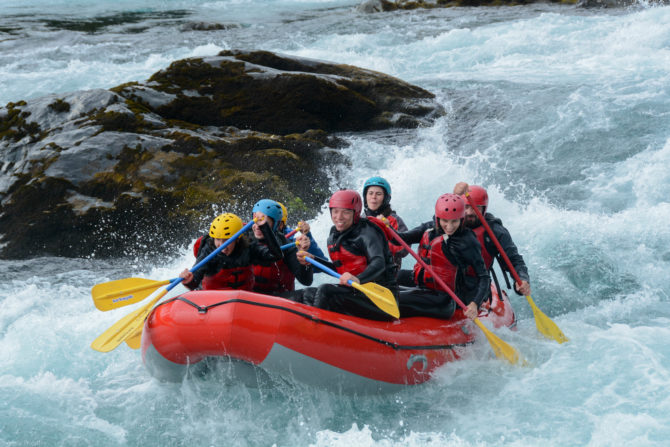
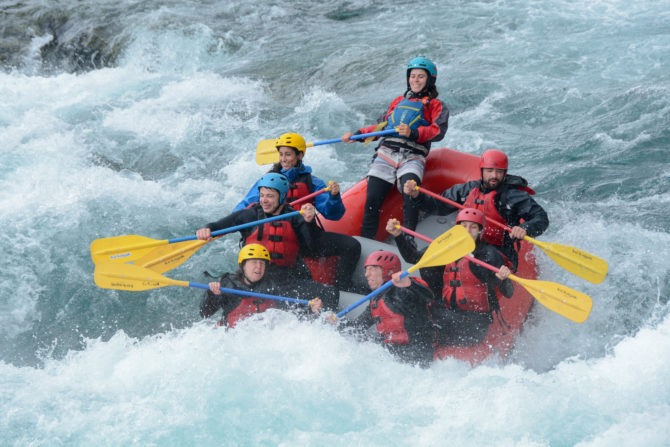
With no New Year’s Day hangover we were free to rent bikes from our hostel and cycle their recommended route to the town of Frutillar. This proved more challenging than we anticipated, beginning with some very bumpy unpaved paths before joining cars on the road. In theory the total length was 32km, but you should discount the not insignificant length I spent walking my bicycle up hills and then sometimes down the other side again, not being a big fan of steepness in either direction. You can get a sense of our struggles by the fact that we had planned to have lunch in Frutillar but ended up eating dinner there instead. (Fortunately we were able to leave our bicycles there rather than riding them all the way home, which would have killed me.)
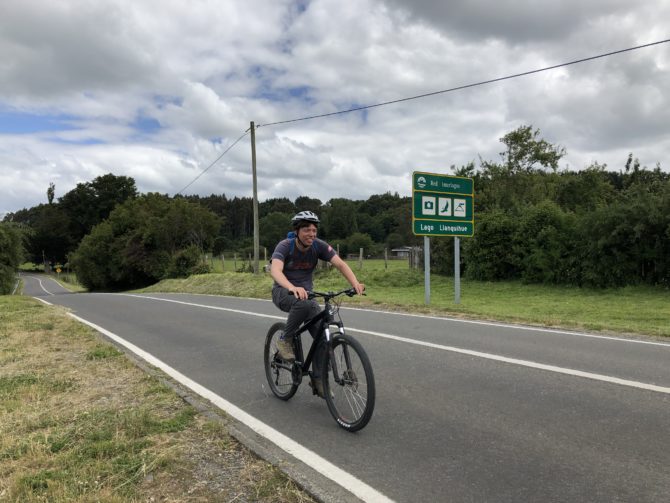
That said, as the pain/terror of the ride fades, I can say now that I’m glad we did it and it certainly felt like a healthy start to the year. After a very hearty meal we came home to watch the Doctor Who Special, which on the whole was rather a triumph. It’s not easy to do something new with the Daleks while keeping them frightening and I thought this was an excellent way of reintroducing them to the show.
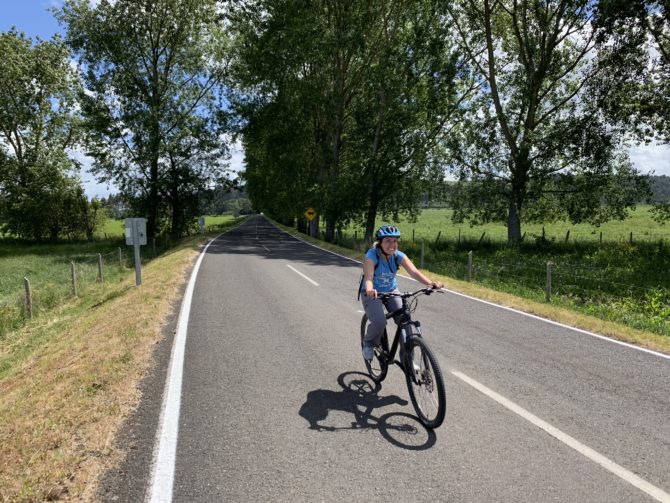
As we waited for the bus home last night at 1am on Christmas morning, we got chatting to a woman from Bosnia and Herzegovina who has lived in Santiago for many years. She was pleased to hear that we really liked the city as apparently many foreign visitors find it “boring” compared to the party town of Buenos Aires. Well, maybe this just shows that we’re boring people (after all, we were catching the bus home rather than out) but Santiago definitely suits us. As Randi pointed out, it is harder to blog about a free-roaming city break compared to a series of tours with set destinations. So apologies (but not really) if this post unduly focuses on transport, but that is the first way that Santiago captured our hearts.
I knew it was a good omen when the guy sat behind us on the bus into town had the Doctor Who theme set as his ringtone.
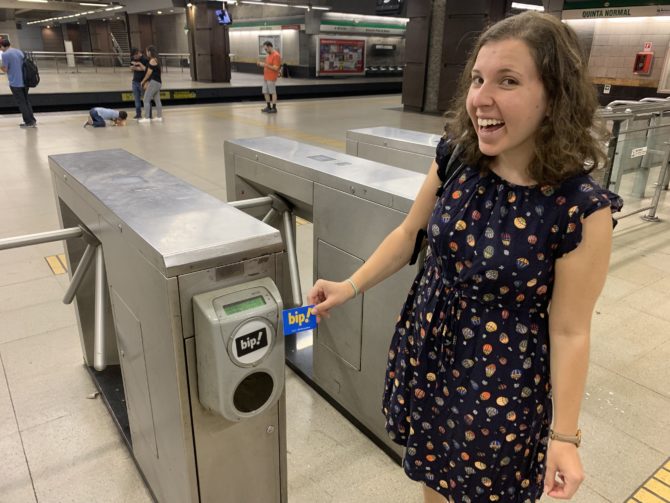
Let’s start with the Metro! Ah, you know you’re in a proper grown-up city when there’s a real metro system. The Santiago Metro is fast and frequent, with a train arriving every few minutes, and we loved it and used it a lot to get around.
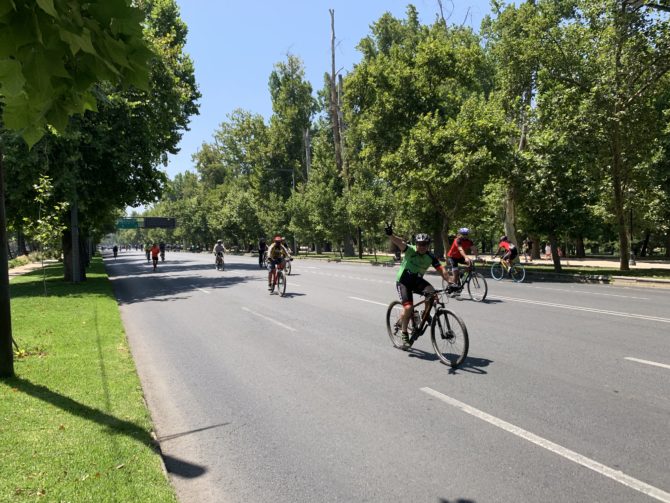
This is closely followed by Randi’s discovery that one of the major roads in the city is closed to all car traffic between 9am-2pm every Sunday for pedestrians, skaters and cyclists (#CompartamosLasVías). This is the icing on the cake for what is already a very walkable and pleasant city centre, and with the cars banished you can actually hear the sound of the River Mapocho flowing by. In the interests of balance, I should say that the River Mapocho is one of the brownest rivers I’ve ever seen. I hoped it might have been mud, but Francisco denies this.
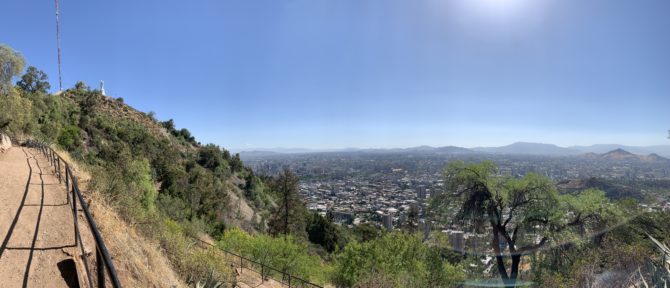
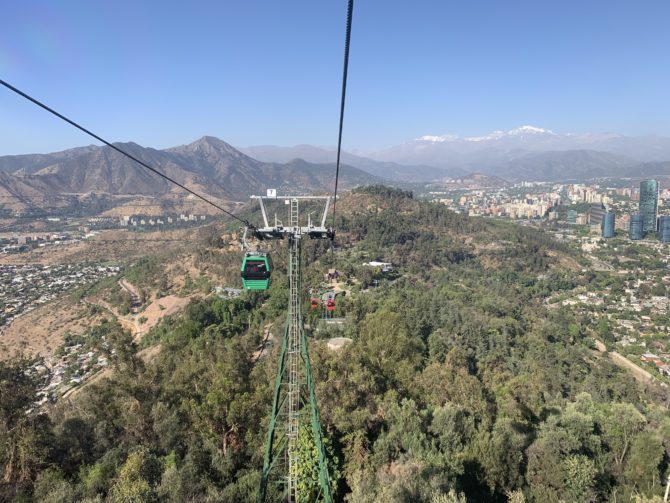
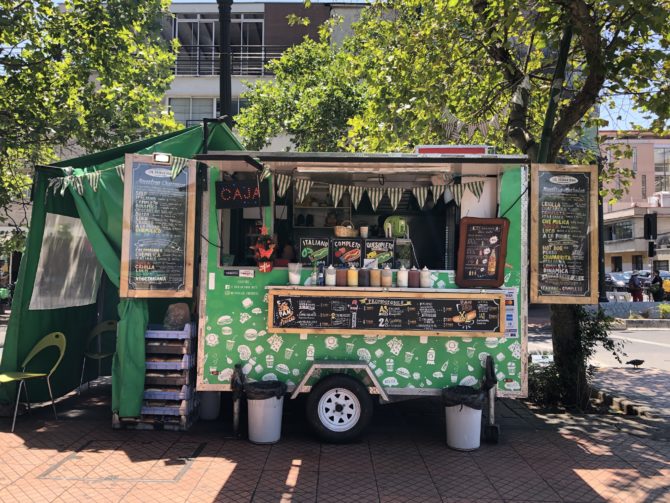
Other than admire the transport infrastructure, on our first day we walked up the summit of San Cristóbal Hill – at which there is a statue of the Virgin Mary and great views of the city below – and then teleférico-ed down again. The next day we took another walking tour, of which one of the highlights was standing in the Plaza de Armas playing the “legal or not” guessing game for issues such as abortion and gay marriage. (Tour guides are young and liberal and they know their audience.)
That night we met up with Francisco for a tour of his old local neighbourhood and favourite restaurant. What he didn’t know was that we would see him again the very next day for his surprise homecoming party in the Parque Padre Hurtado. A word about this park. It is very nice inside, but for some reason they have decided to charge an entrance fee of 500 pesos, which means that most of the entrances are locked shut and you have to walk all around the park to get in. Amusingly, it’s another 500 pesos if you want to bring your dog in with you.

On Francisco’s recommendation, we also visited the Museum of Memory and Human Rights which covers the period of dictatorship in Chile. Although it is largely about those who were tortured, killed and ‘disappeared’ during the rule of the military junta, one of the most striking exhibitions for me was about the 1988 referendum which (narrowly) ended Pinochet’s rule. It’s just so odd, because half of the exhibition looks like any normal election campaign (TV spots, badges, slogans) but alongside are the stories of the parallel vote-counting operation mounted by the opposition and the CIA reports on Pinochet’s preparations for violence if it looked like he was losing. Still, despite everything, it is incredible that the dictatorship ended and democracy was restored through this vote.
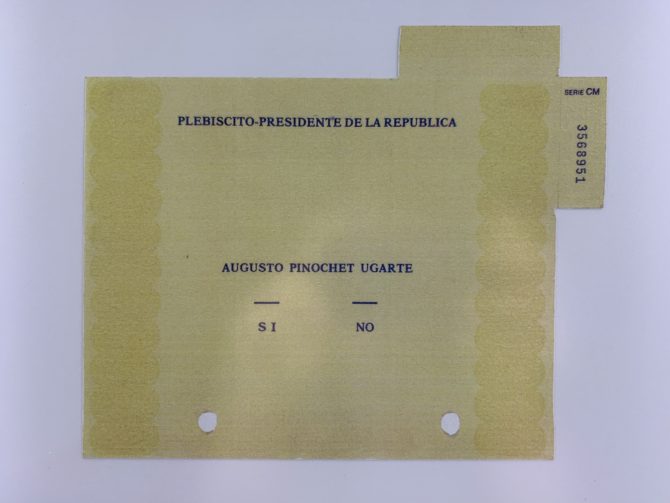
We were very honoured to be invited by Francisco and Carolina to join their family for Christmas, which in Chile (as in lots of places) really means ‘Christmas Eve’. (Yes, this means that children wake up on 24th December and have to wait all the way until midnight for Santa to bring their presents, which seems like it would require incredible patience.) At Francisco’s uncle’s house in the suburbs we took our seats in the garden and feasted on a traditional Christmas dinner of turkey, potatoes and ceviche, while asking all the questions about Chilean society which you can’t quite go into on a walking tour. For example, the rather long-winded and euphemistic English phrase “trying for a baby” is known here as being “in campaign”, which has slightly disturbingly violent connotations but I admire for being much snappier.
After dinner we gathered around the tree for Secret Santa. You think you know how Secret Santa works, right? Well, Francisco’s family have added a terrifying twist that if you can’t guess who your present came from in two guesses, your present is confiscated and held in ‘penitentiary’ until the end when you might be allowed to tango for its release. This is all accompanied by a lot of chanting in Spanish, which is all the more frightening if you don’t really understand what’s being said. Fortunately Randi and I were given strong hints about the identities of our gifters, along with incredibly generous (and useful!) travel-related gifts themselves.
It was really lovely to be allowed to gatecrash a family Christmas here, even if it winds up making Christmas Day itself feel more like Boxing Day. Tomorrow morning we leave Santiago and fly further south down this excessively long country, but we have really enjoyed our stay here, especially since we’ve had our own place for six nights with our own little balcony to sit, read, eat, drink and blog in the sun.
Feliz Navidad!
